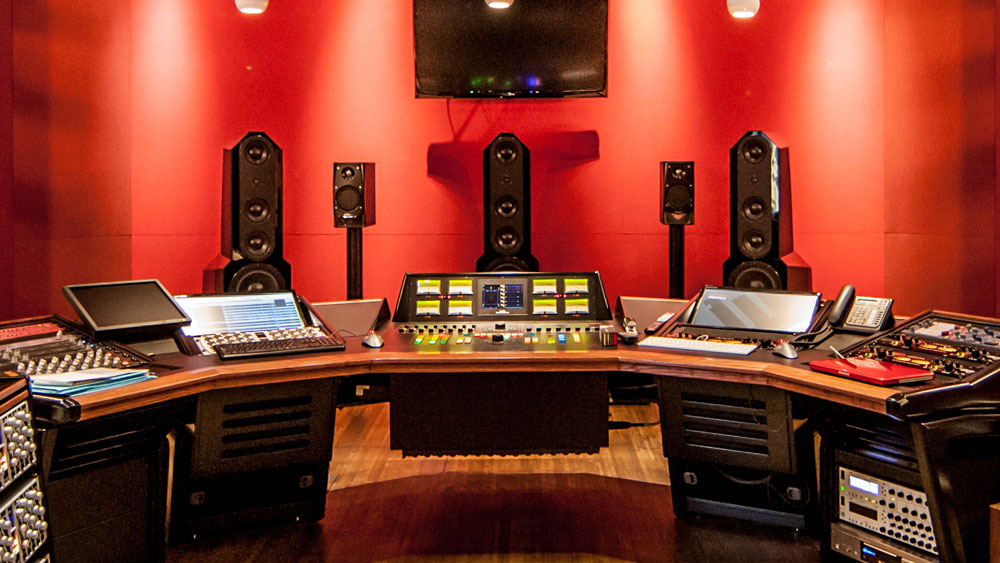
The outstanding sonic and technical features quickly got around in the scene – so further orders were not long in coming.
Besides the MMC 1, another legendary product with 120V technology was created with the PQ, the “King of Parametric Equalizers”.
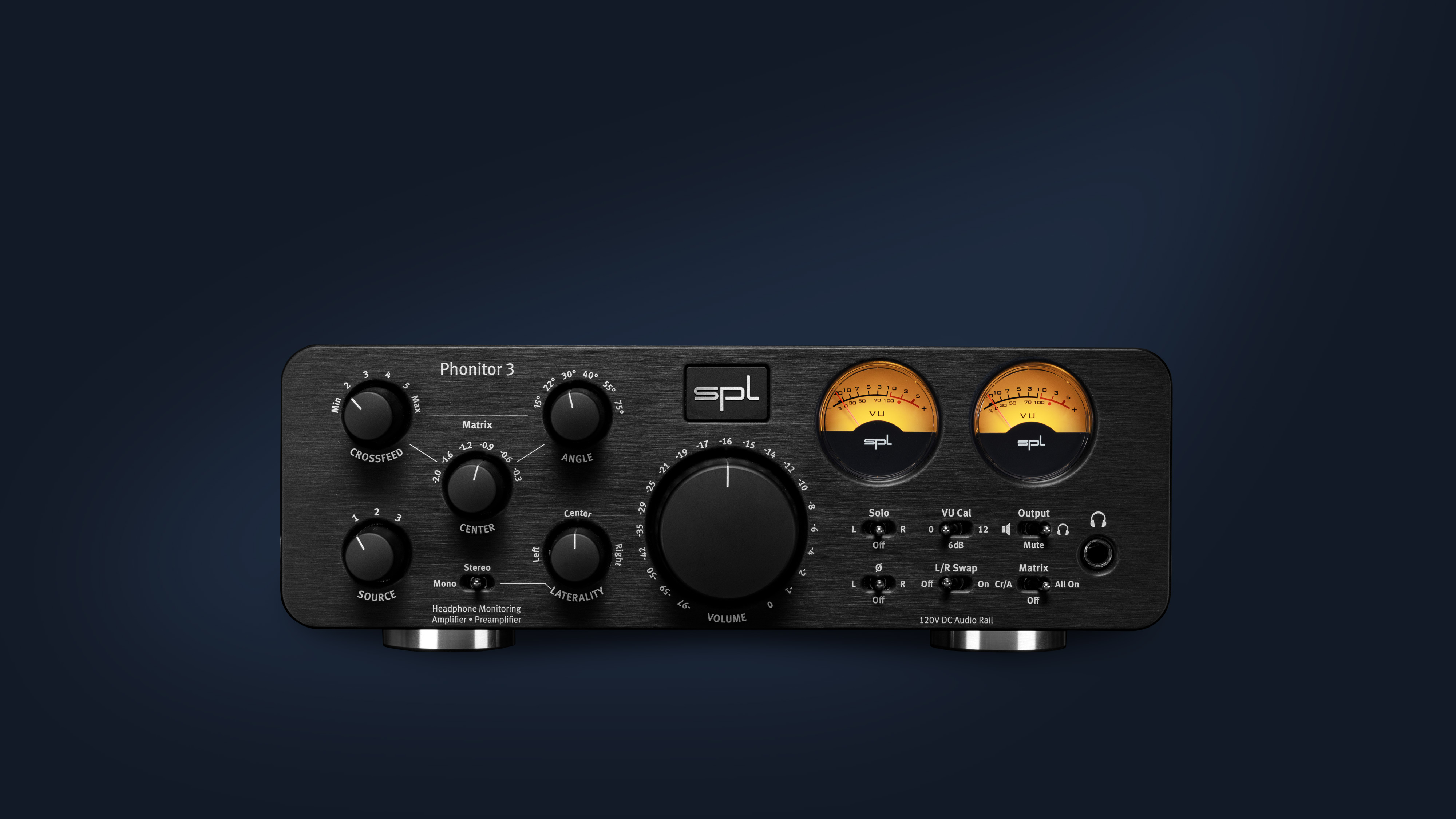
Phonitor 3 is the ultimate headphone amplifier and monitoring controller with 120V technology.
It offers the same monitoring quality as the big SPL mastering consoles –
on loudspeakers and headphones.
The analog Phonitor Matrix allows mixing and mastering on headphones in the highest quality –
with the same spatial perception of the stereo stage as on loudspeakers.
Three analog XLR stereo inputs for various sources and a wide range of monitoring options make it the perfect monitor controller for demanding producers and mixing/mastering engineers.
Phonitor 3 can be equipped with the optional Expansion Rack, which is not only a 19″ rack housing,
but it also expands the connection possibilities with three additional switchable stereo outputs for active loudspeakers or power amplifiers.
The Phonitor 3 offers connection for a standard headphone with a stereo jack plug on the front. Thanks to the enormous output power, all kind of headphones are driven effortlessly. Thus, it plays out the advantages of the SPL 120V technology and rewards the listener with an honest, detailed and at the same time vivid sound experience.
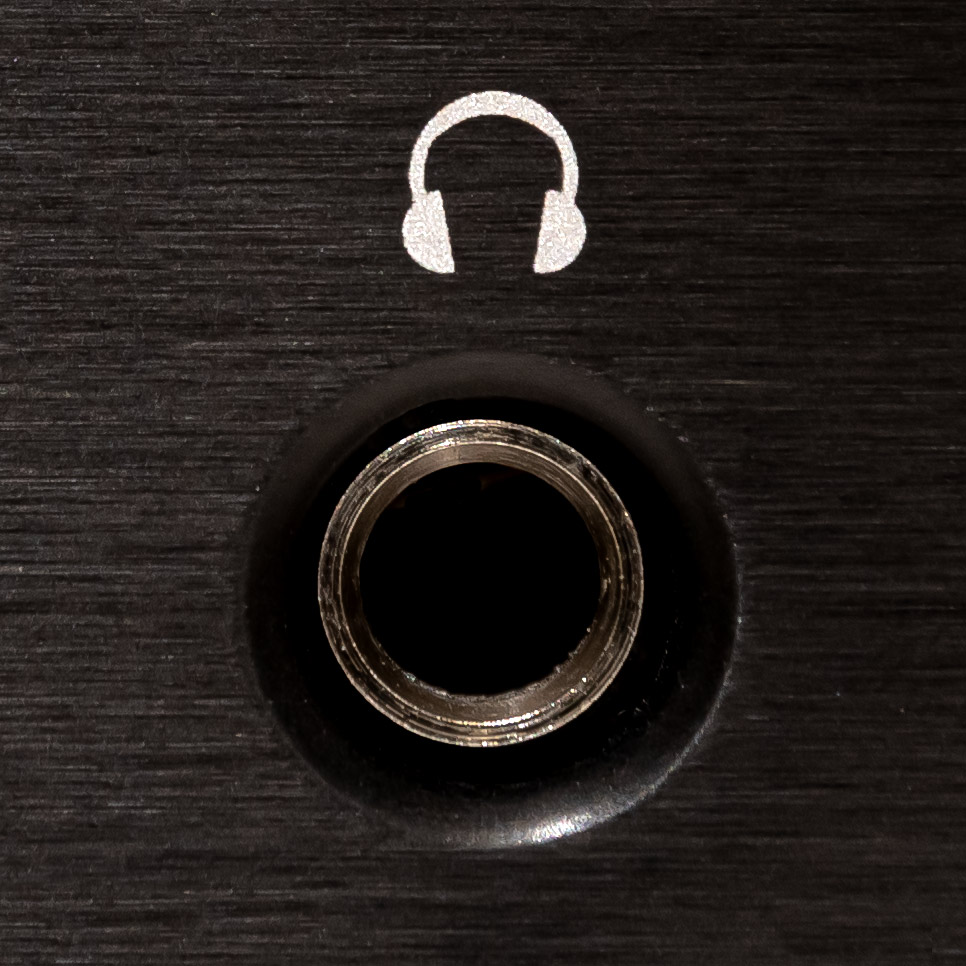
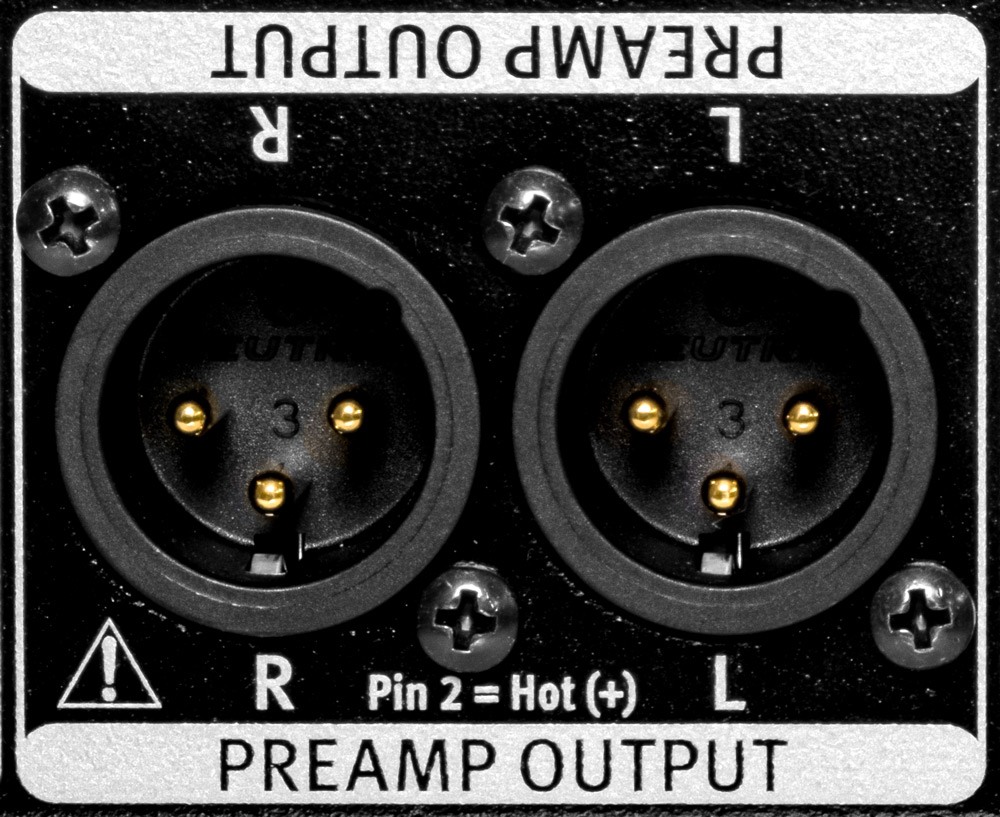
On the rear of the device, Phonitor 3 offers
a stereo output which makes it a high-quality
monitoring controller for any monitoring situation. Active speakers with an integrated power amplifier
or passive speakers in combination with a power amplifier can be connected at this output.
Phonitor 3 offers the same key technology –
SPL 120V technology – and signal quality as the
big SPL DMC and MMC mastering consoles.
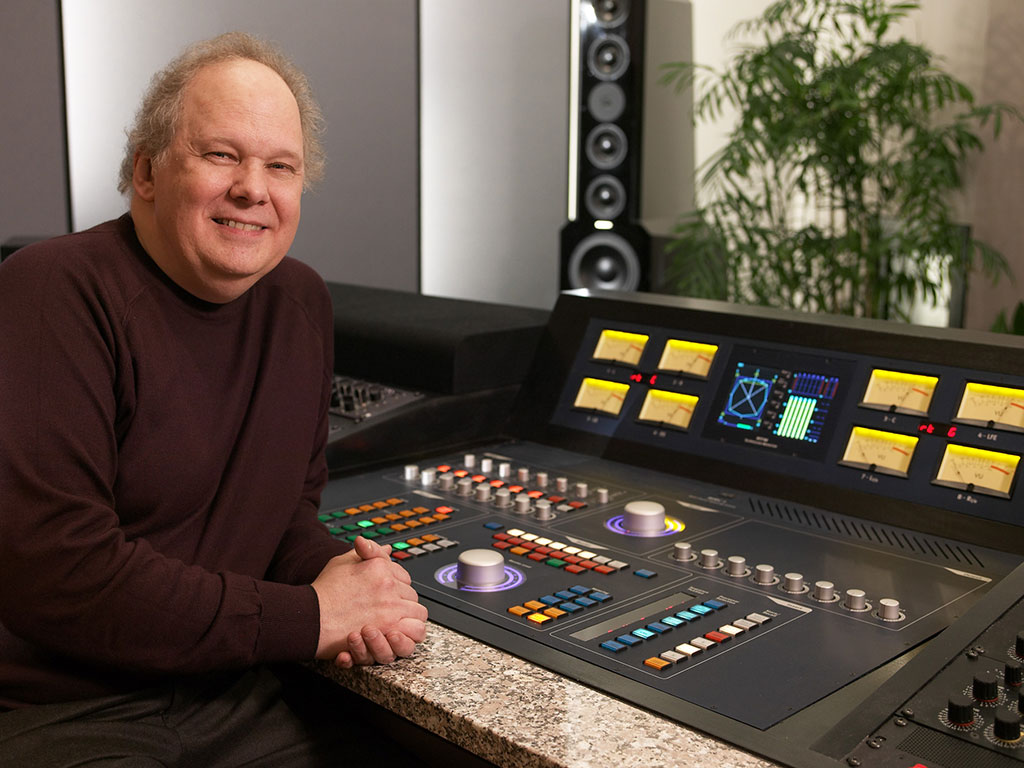
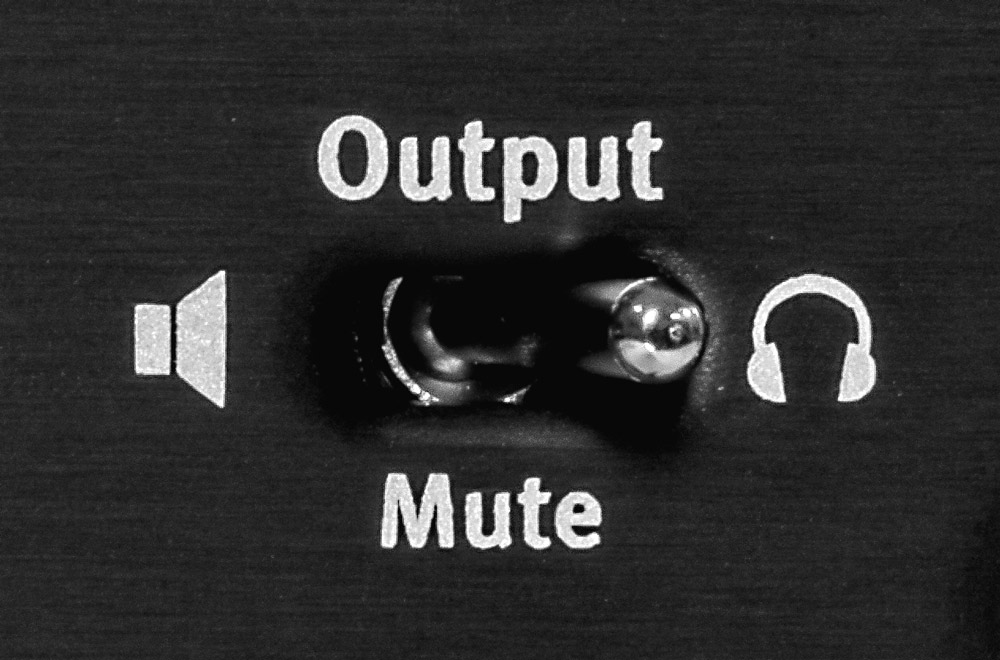
The Output switch – simply switch from headphone to speaker playback. In the center position (Mute), no signal reaches the outputs.
The VU meters light up red.
Up to three stereo sources can be connected to the Phonitor 3.
The source is selected via the Source switch.
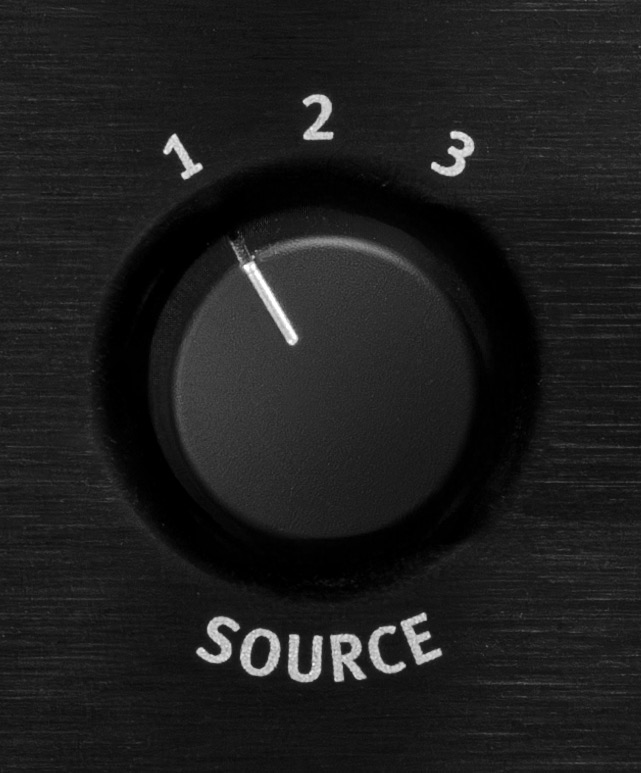
Three analog stereo inputs are offered, each with two XLR line inputs (left channel, right channel). Professional analog players with balanced outputs and line level can be connected here, for example high-quality DA converters or an audio interface.

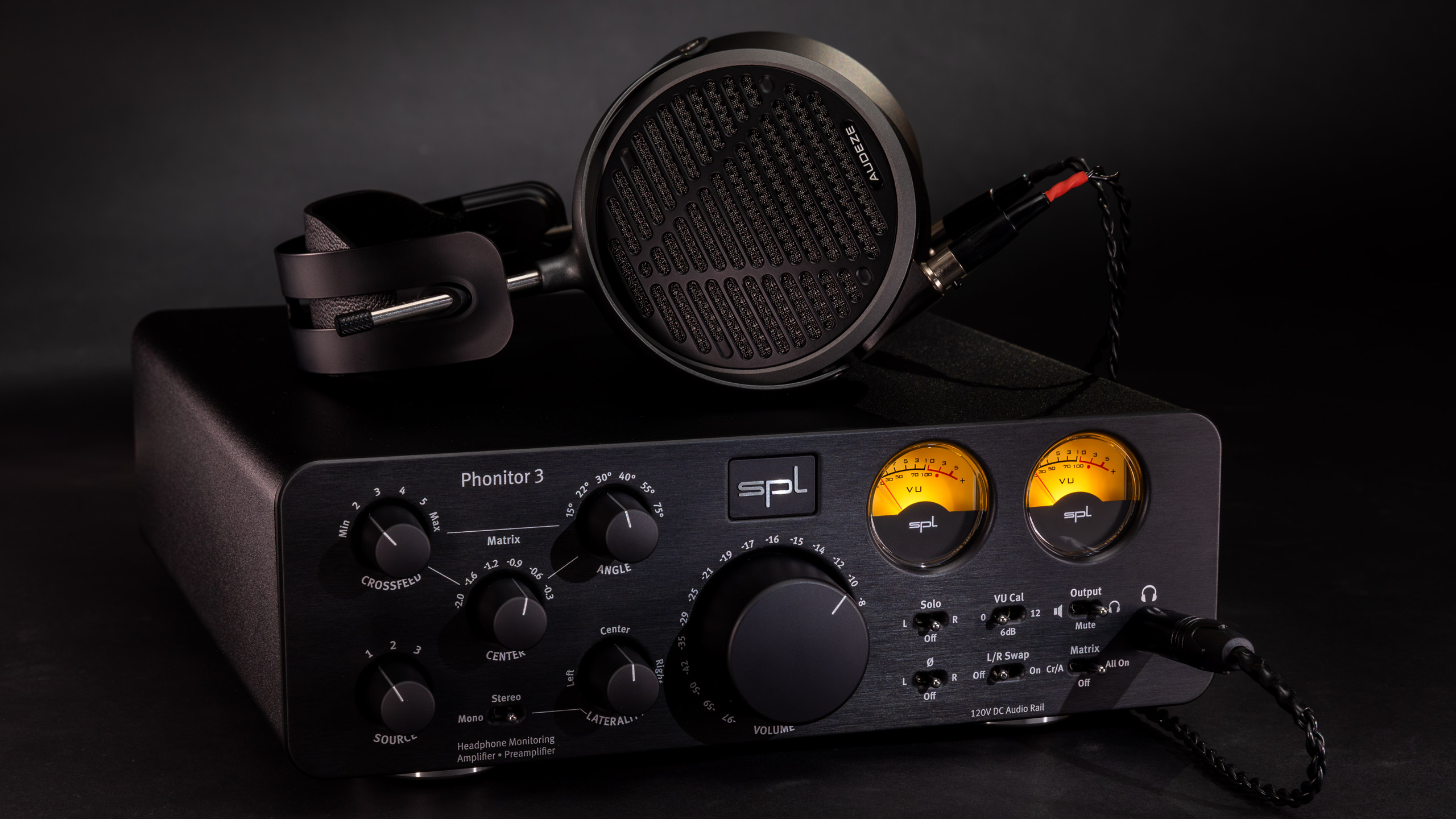
The massive 45mm volume control knob milled from aluminum is a haptic highlight. Its mass together with the Alps RK27 “Big Blue” potentiometer enhances the “spoon in the honey” feeling even further and provides perfect control of the monitoring level.
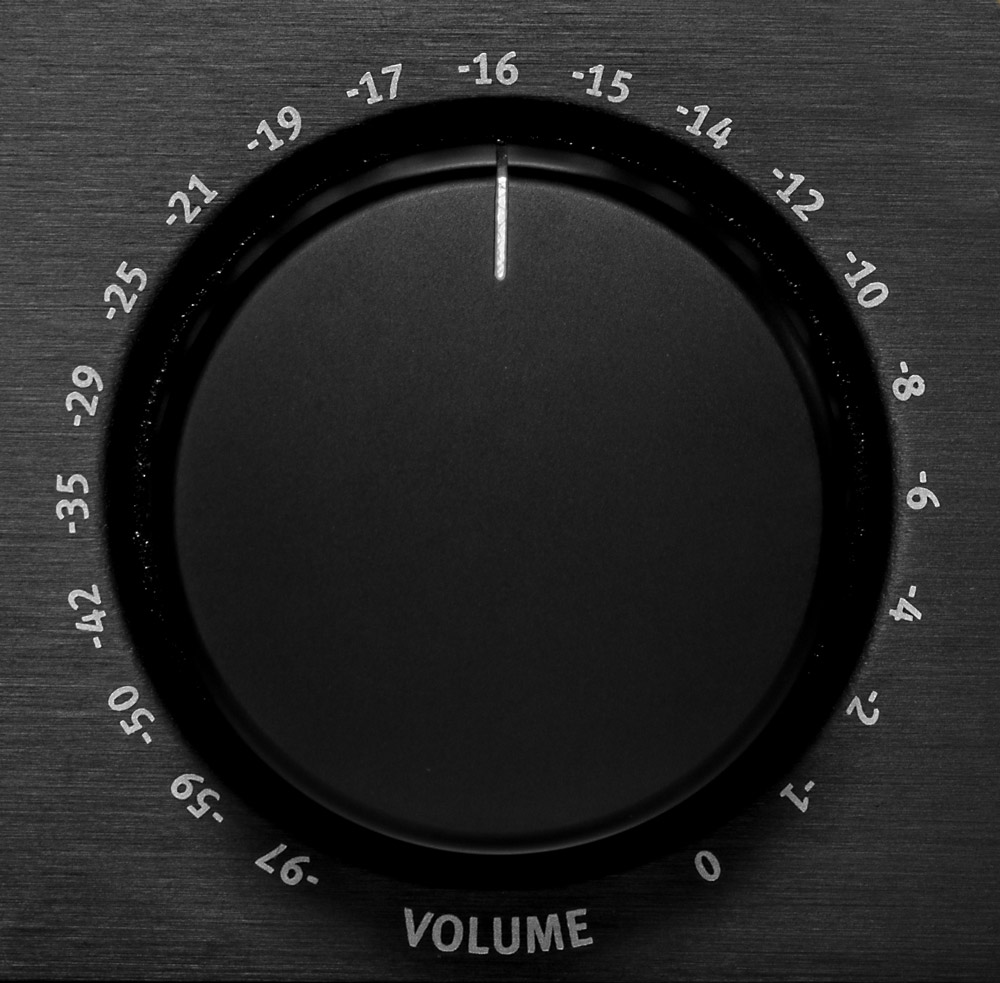
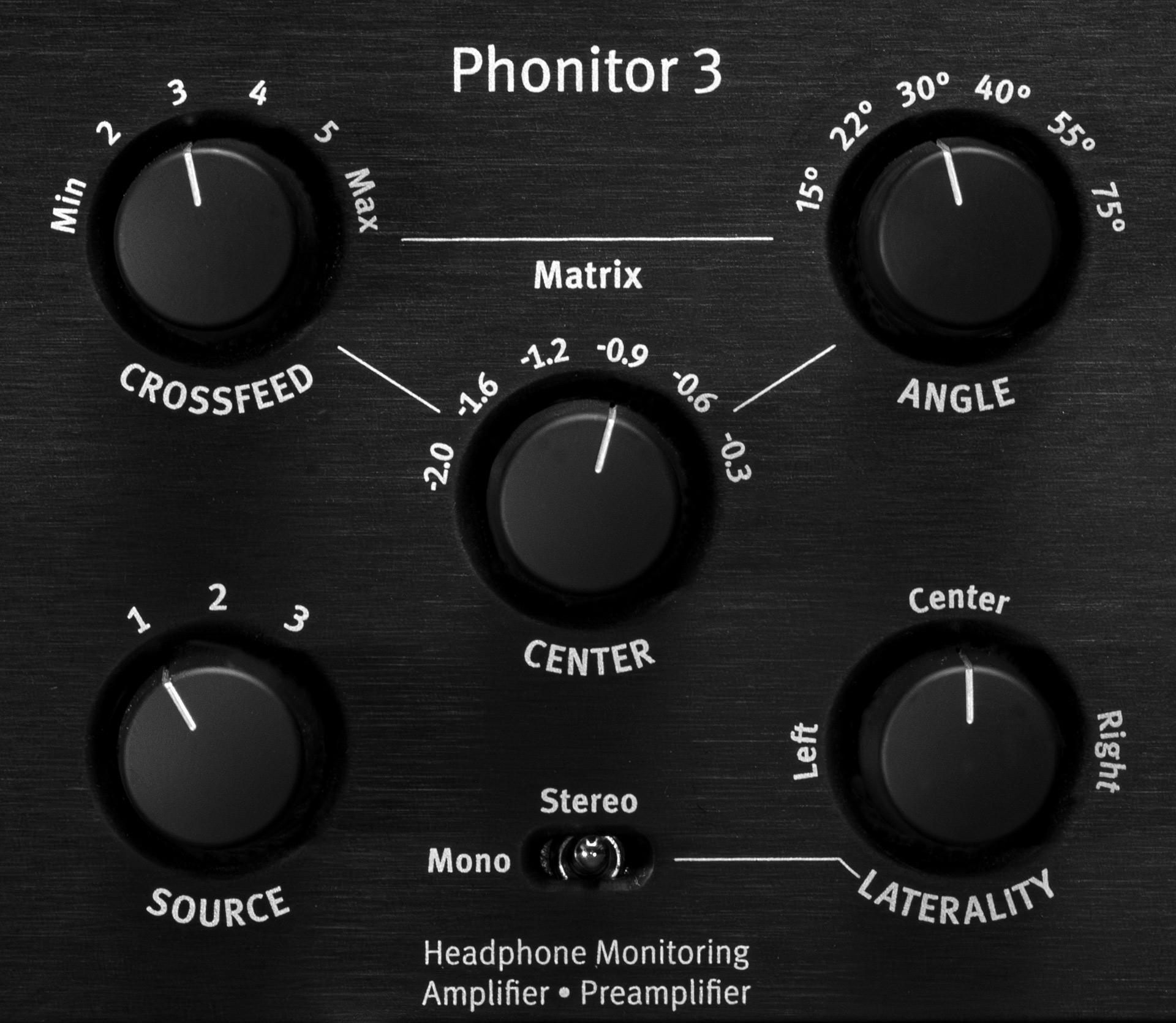
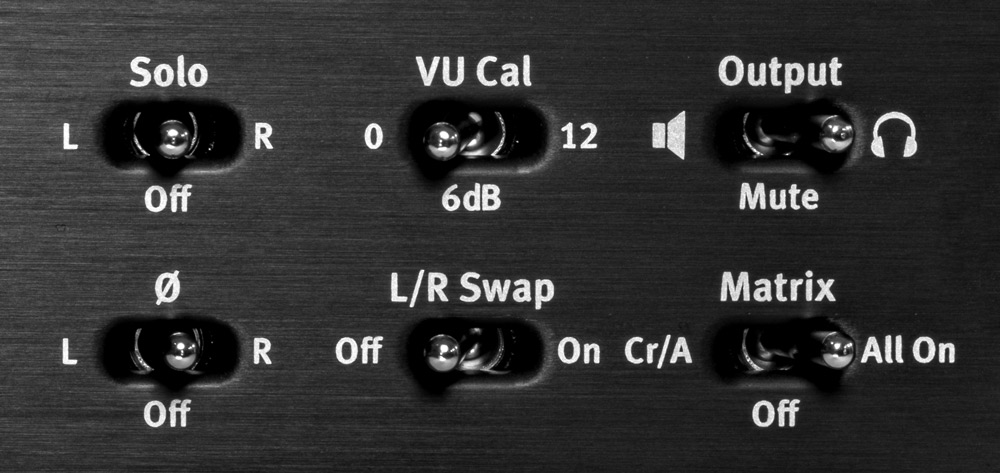
The Phonitor 3 is a full-fledged
monitor controller:
The Mono/Stereo switch can be used to select whether the output signal of the Phonitor 3 is a regular stereo signal or whether it is summed to a mono signal.
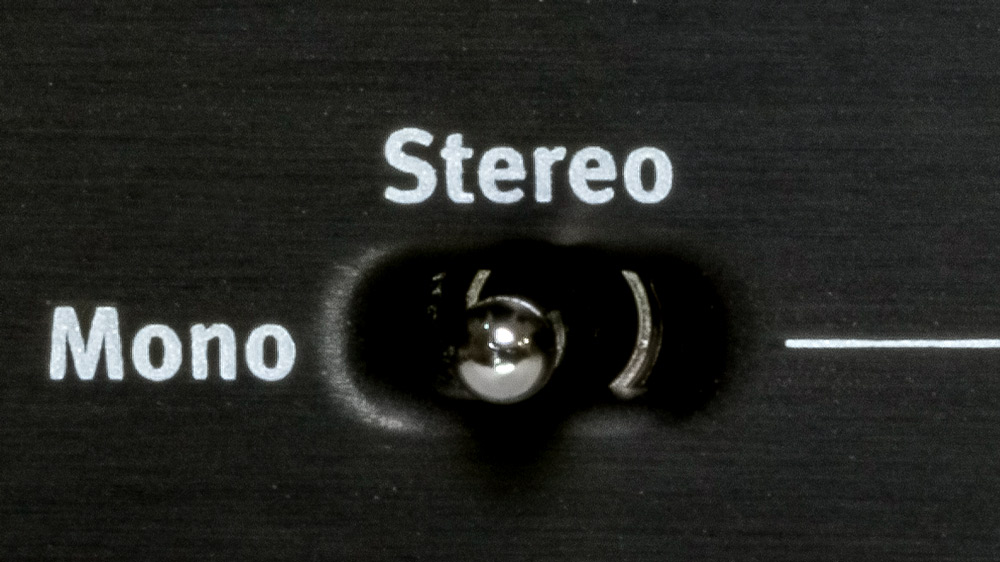
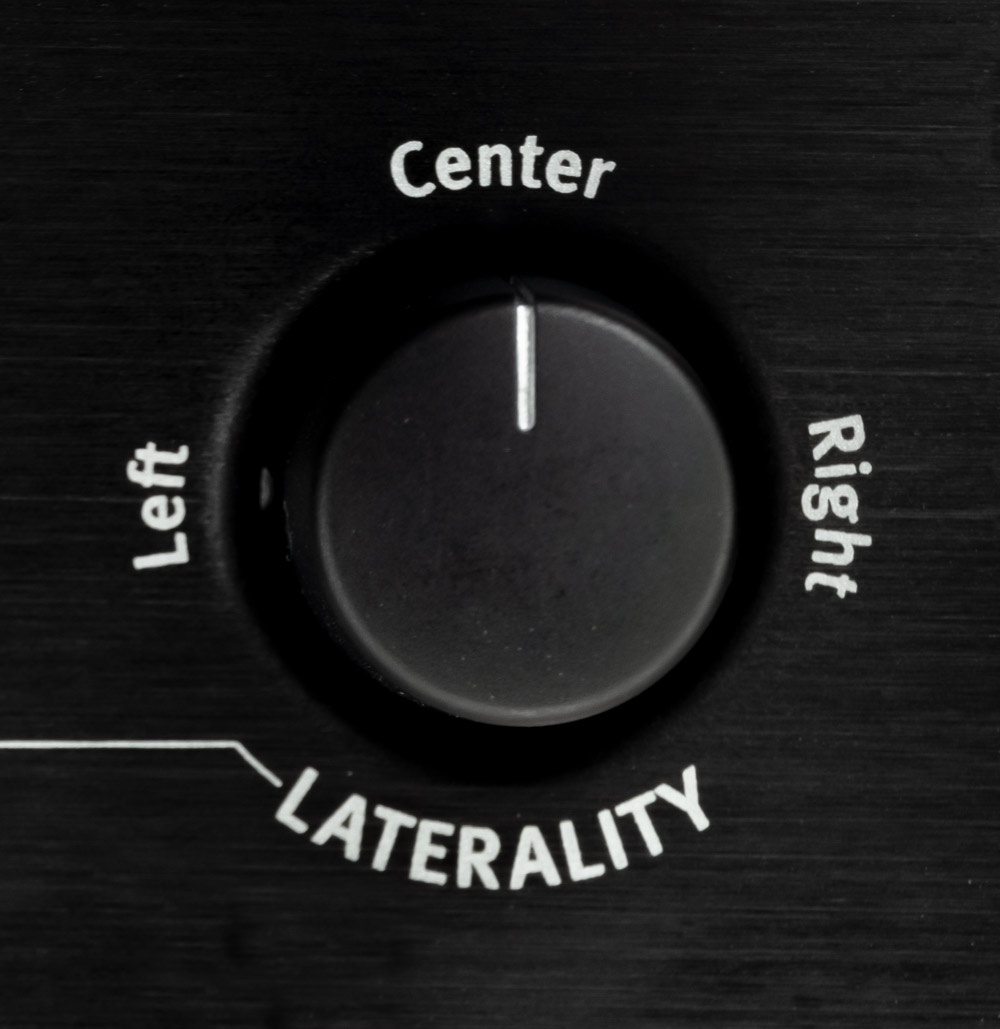
Naturally, hearing can be directed more to the left or more to the right.
This becomes particularly clear when listening on headphones.
Therefore, the Phonitor 3 has the uniquely finely resolved laterality control, which rebalances the stereo image on the monitoring side.
The Mono/Stereo switch can not only be used to switch between stereo or mono playback. This switch is also used to activate or deactivate the laterality control.
Only the right or left channel of the audio signal should be played back?
The Solo L/R function makes it possible. If the triple selection switch is
in the “L” position, only the left channel is played back – if it is in the “R” position, only the right channel is played back. In the middle position “Off” the Solo function is switched off. The regular stereo signal consisting of the left and right channel is thus present at the output of the Phonitor 3.
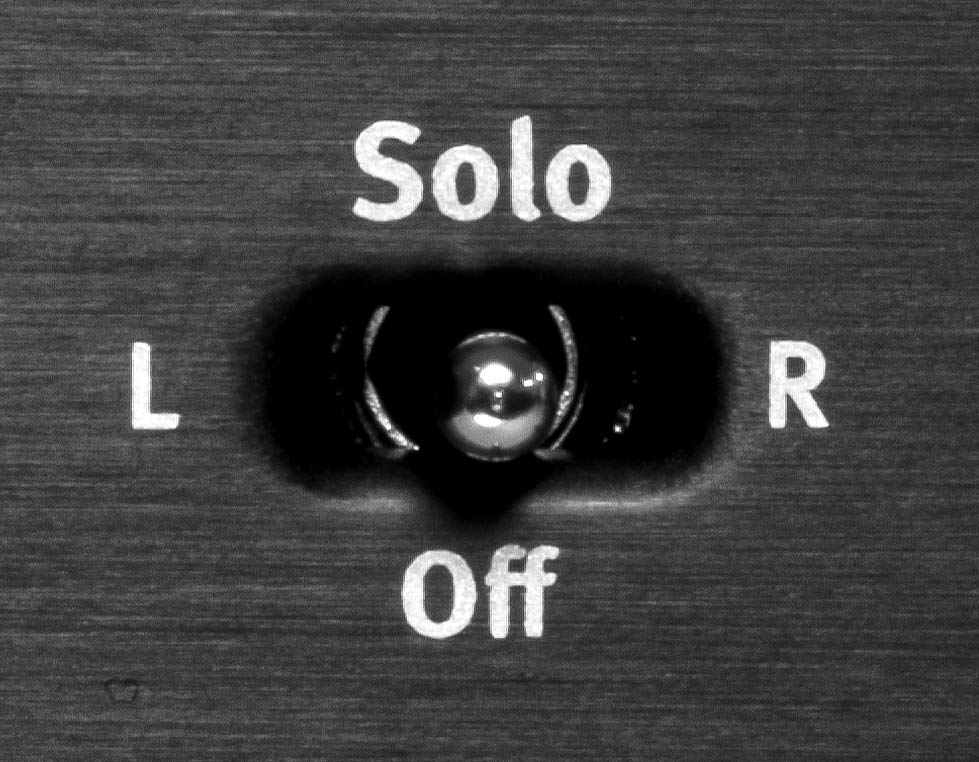
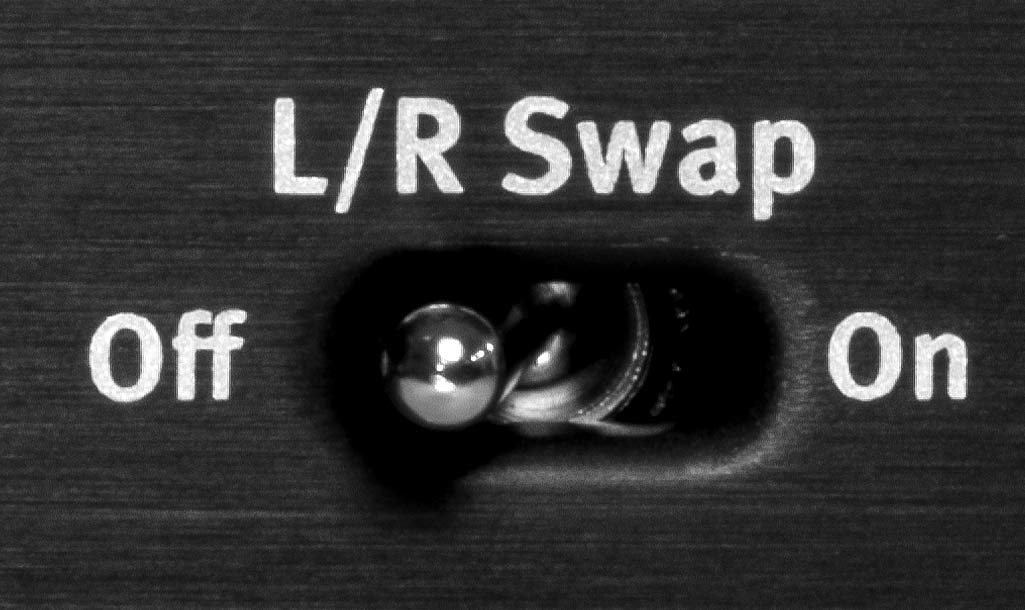
A special feature is the channel swap function: L/R Swap.
This function inverts the stereo image. Left becomes right and right
becomes left. This is especially important and extremely time-saving, when you are monitoring samples in video dubbing that should match a scene with direction of movement. If the direction is not correct, you usually have to load the sample into the DAW to switch channels. before you can judge whether the sample matches the image. With the L/R Swap function, this is no longer necessary. You can now adjust the direction of movement on the Phonitor 3 while pre-listening the sample library.
With this switch the phase of the left or right channel of the audio signal can be inverted. If the three-way selection switch is in the “L” position, the left channel is inverted – if it is in the “R” position, the right channel is inverted. In the middle position “Off” this function is switched off. At the output of the Phonitor 3 the regular stereo signal is thus present.
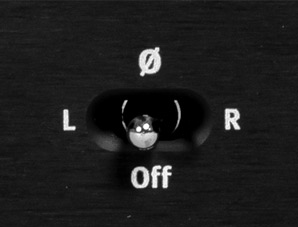
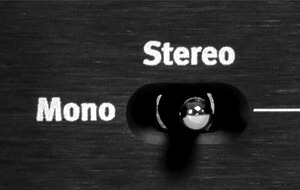

By using the mono/stereo and L/R phase inversion switch in combination, it is also possible to only monitor the mid or side signal. When the switch is set to “Mono” and phase inversion is active for L (or R), only the side signal is played back.
If the phase inversion is switched off, the mono signal corresponding to the “M” signal is played back. Separate monitoring of the M and S signals has become a widespread standard for many mixing and mastering engineers.
Two mechanical VU meters visualize the input levels for the left and right audio channels.
The “VU Cal” switch can be used to reduce the signal visualized on the VU meters by -6 dB or -12 dB.
Thus, the VU meters operate in the ideal display range even at very high input levels.
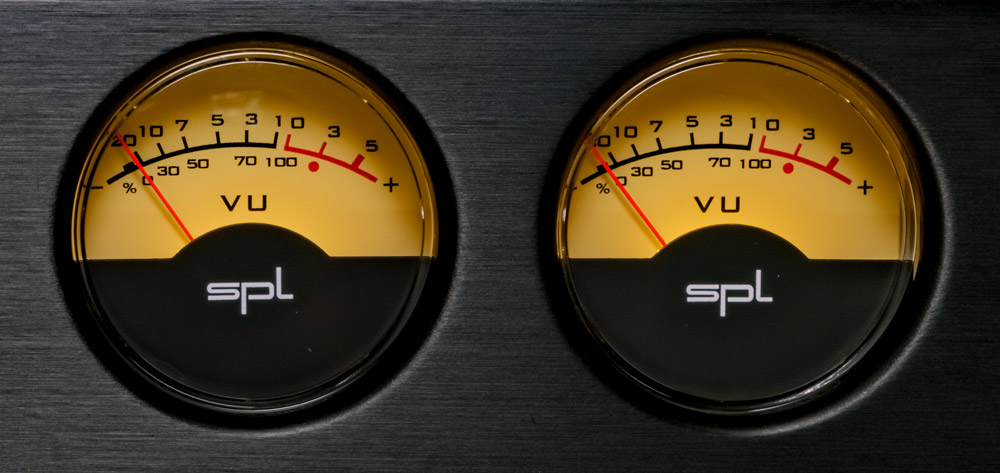
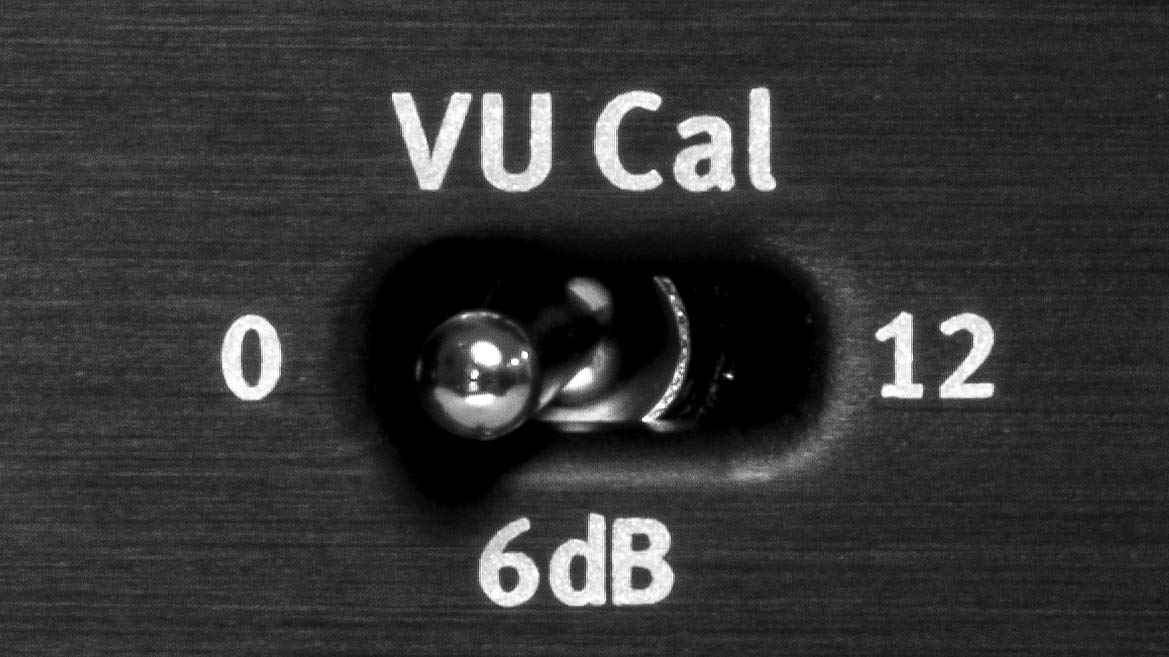
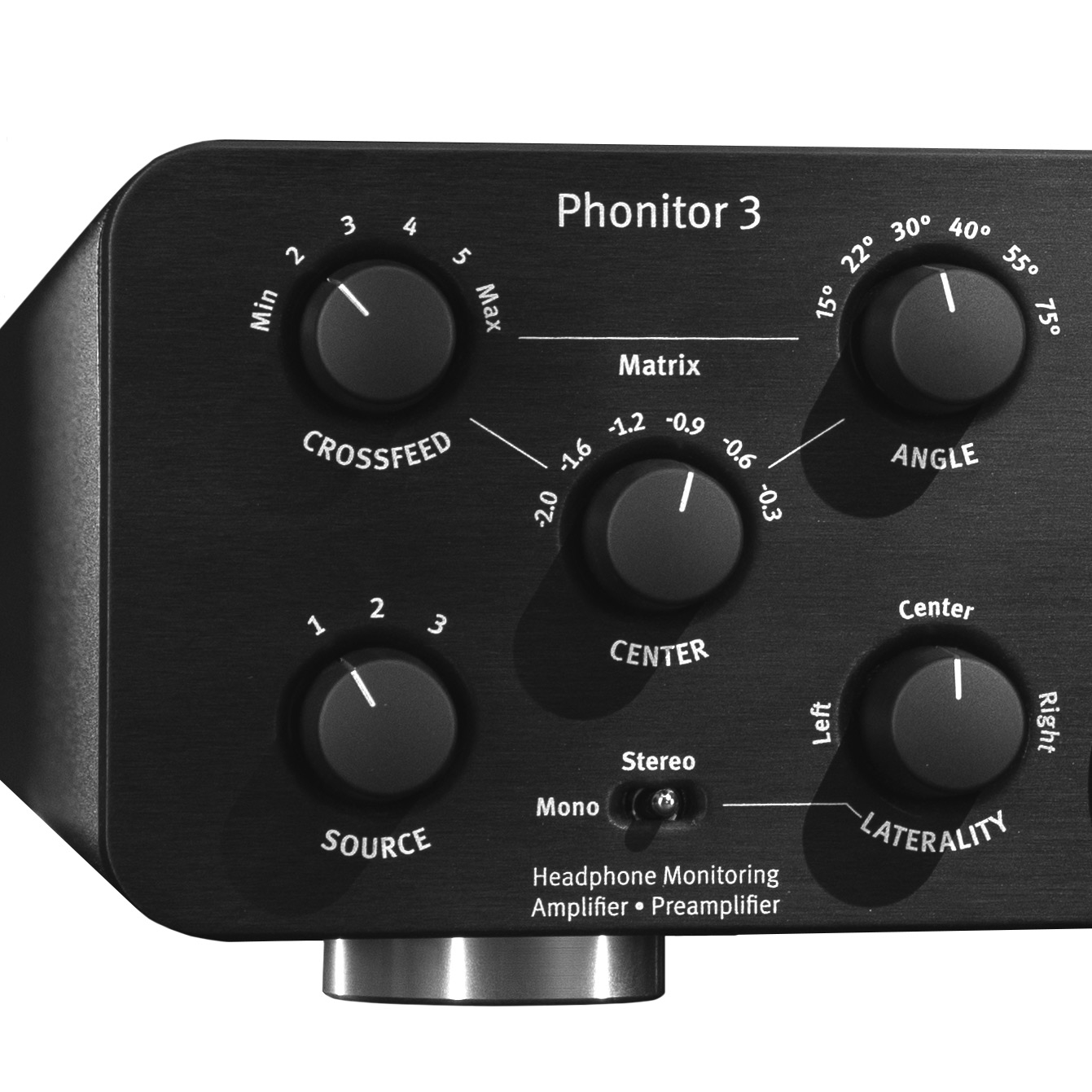
One of the unique features of SPL headphone amplifiers is the SPL Phonitor Matrix. It enables mixing and mastering engineers to create perfect mixes on headphones, which will translate perfectly to all types of stereo speaker systems.
But the Phonitor Matrix is not only designed for professional use in the studio. It also enables the hifi enthusiast to enjoy music on headphones, like if it was played back on speakers.
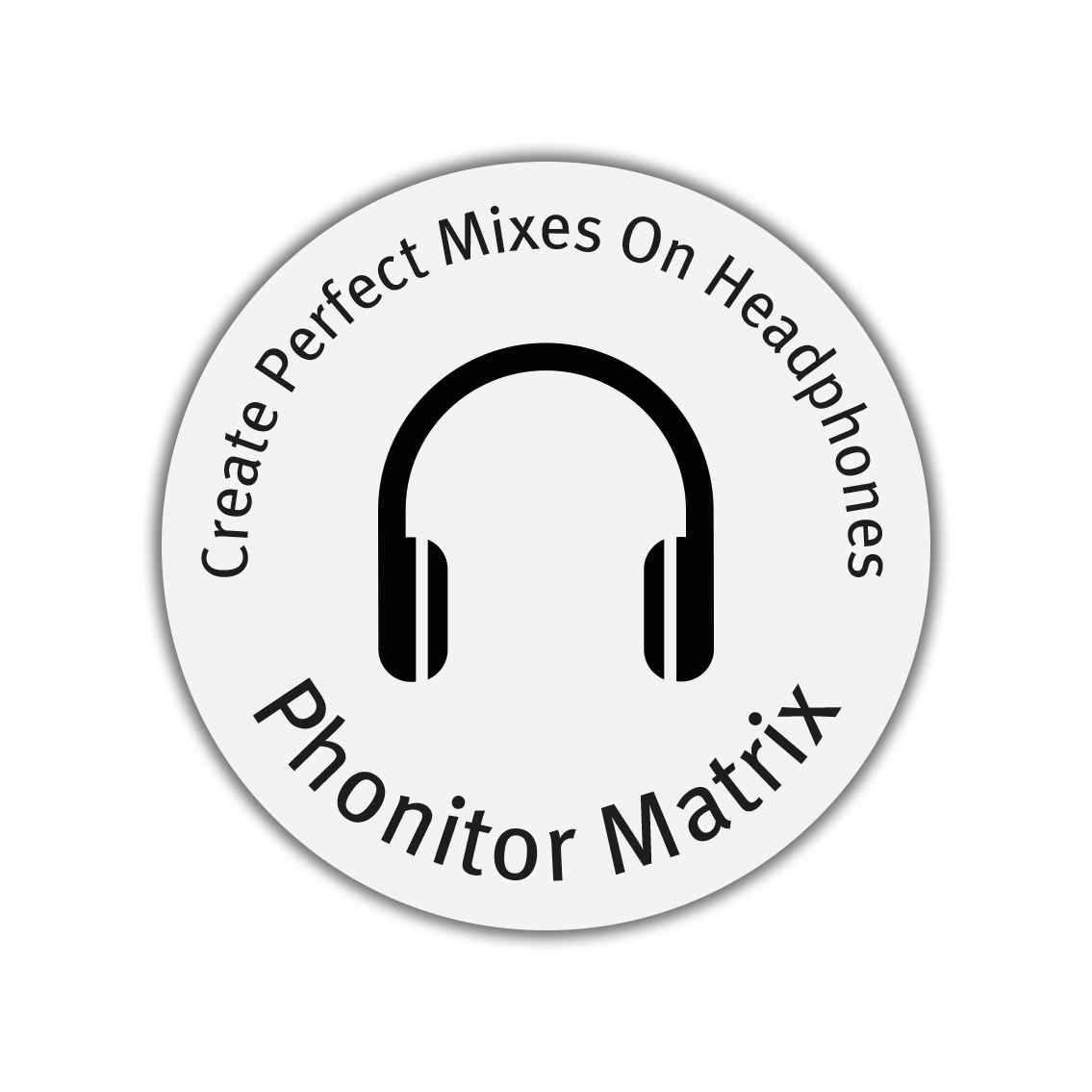
The Phonitor Matrix allows the mixing and mastering audio engineer to create perfect mixes on headphones that sound great on all types of stereo speaker systems.
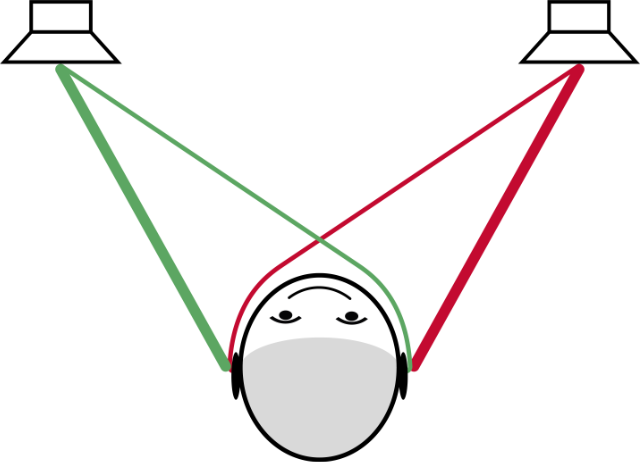
Listening on headphones is different from listening on loudspeakers.
The biggest difference is the lack of crossing signals of the sound signal from the left speaker to the right ear and from the right speaker to the left ear.

This results in an unnaturally wide and
wrong stereo image.
The various sound sources of the audio signal are not localized as the sound engineer intended them to.

The SPL Phonitor Matrix will correct this false stereo image with an analog circuitry and ensures a correct representation of the stereo image and a relaxed listening experience.
Music is normally produced and mixed for playback on stereo speakers.
Listening on headphones is different from listening on loudspeakers. The biggest difference is the lack of crossing signals of the sound signal from the left speaker to the right ear and from the right speaker to the left ear.
These crossing signals are missing in conventional headphone listening, because there are no signals crossing from one side of the headphones to the other. This results in an unnaturally wide stereo stage and sound sources are not played back at their actual position in the stereo spectrum.
The SPL Phonitor Matrix can correct this false stereo image with an analog circuitry.
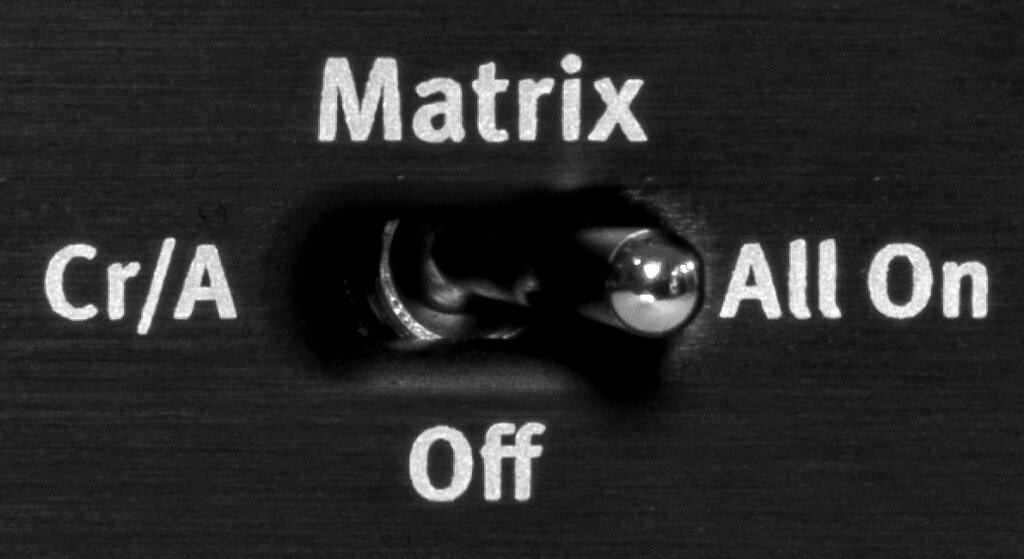
With the Matrix switch you can activate the Phonitor Matrix
– with the Center function (All) or without (Cr/A).
In the Off position, the Phonitor Matrix is deactivated.
The Phonitor Matrix creates a speaker-like listening experience on headphones, by mixing the left and right signals, each delayed (interaural time difference) and attenuated (interaural level difference), to the corresponding opposite side.
The two main parameters of the Phonitor Matrix are Crossfeed and Angle:
Crossfeed determines the crossing signals of the channels.
Angle determines the opening angle of the stereo image.
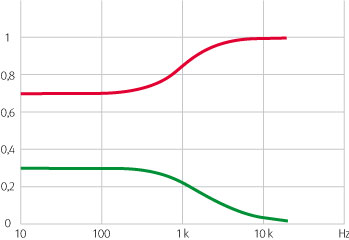
Level and frequency corrections of the right (red) and left audio channel (green) at maximum crossfeed.
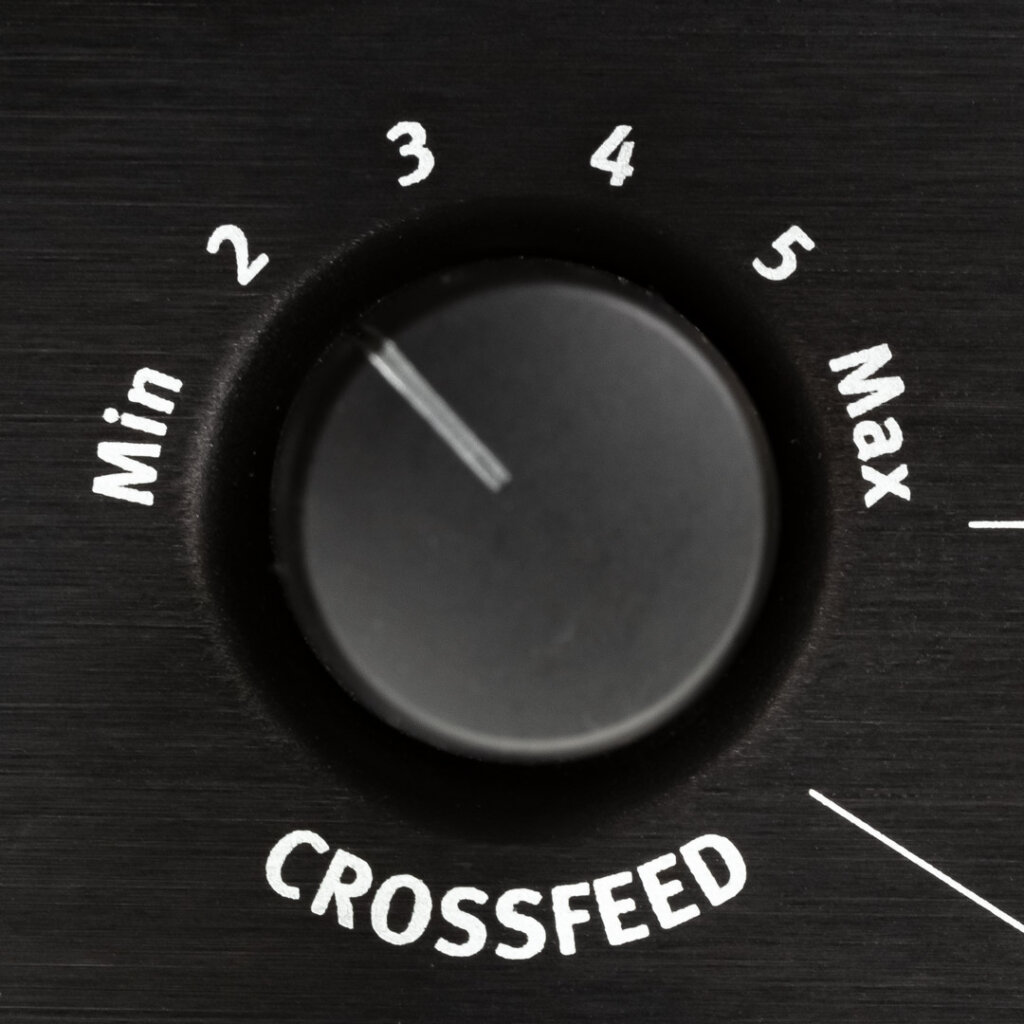
With the Crossfeed switch you can adjust the interaural level difference. The level difference is comparable to the influence of different room sizes and their reflection and absorption characteristics. The interaural level difference is frequency-corrected because the sound is reflected and absorbed by the head in a non-linear fashion.
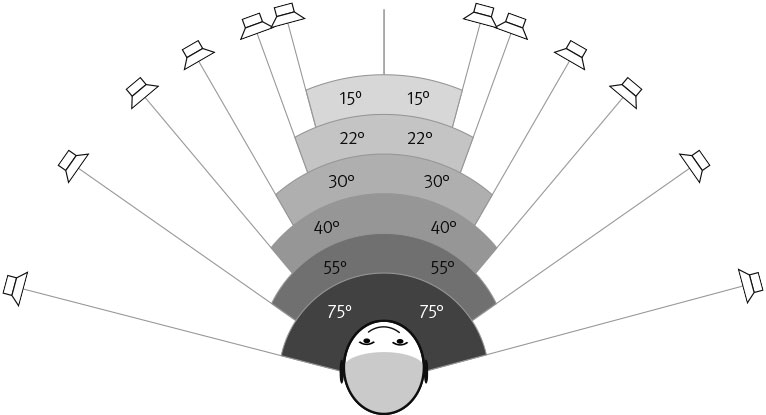
Settings for the speaker placement angle to determine the interaural time difference.
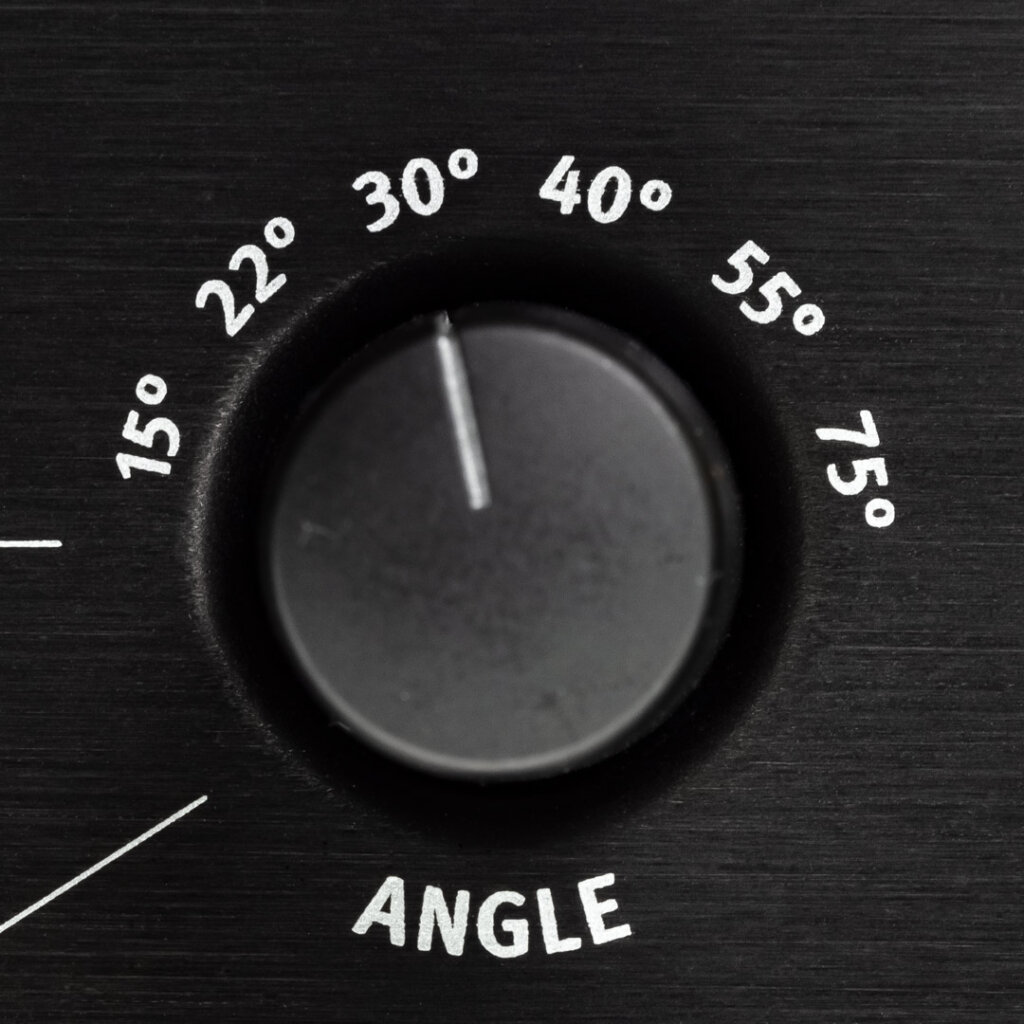
With the Angle switch you adjust the interaural time difference which is related to the placement of the speakers. The interaural time difference is frequency-corrected because the sound is reflected and absorbed by the head in a non-linear fashion.
During conventional listening on headphones, our brain can compensate a certain level of false playback representation – but this is very exhausting and leads to listening fatigue.
To make the listening experience even more perfect, the level of the center of the stereo image needs to be attenuated when the Phonitor Matrix is active. This ensures that not only the position of all sound sources is correct but also their volume.
In most Phonitor devices this value is set to a fixed
attenuation of -1 dB, which is the best choice for getting
an authentic representation of the sound stage.
Phonitor 3, designed for the most advanced mixing
and mastering applications, allows to adjust the center level in in fine steps of 0.3 dB or 0.4 dB with the
“Center” switch.
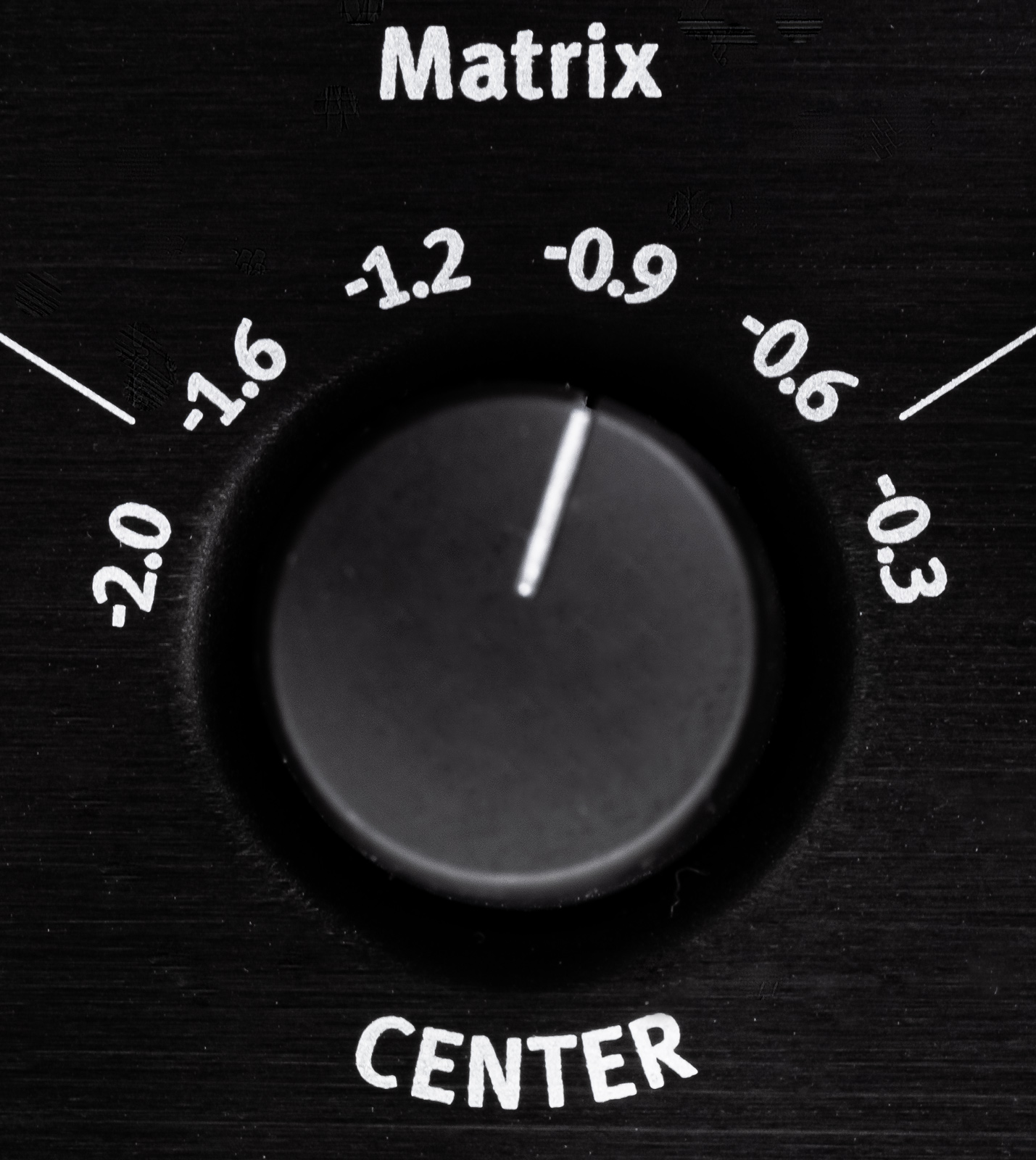
When activated (Matrix switch = All) you control the intensity of the center signal with the Center switch. If the stereo width is narrowed through changes in Crossfeed and Angle (so as to correspond to your actual loudspeaker setup), the phantom center may likely sound too intense while mixing on headphones.
You normally would counteract by lowering the mid signals in the mix. However, listening to that mix on loudspeakers the phantom center appears to quiet.
Attenuating the center allows the center signal to be adjusted back to the appropriate ratio of volume in relation to the stereo signal when mixing on eadphones, so that the phantom center gains the correct volume in relation in relation to the stereo signal during speaker playback.
The SPL Phonitor Matrix corrects the false representation of the stereo sound image, which makes it much easier to find the right decisions for mixing and mastering engineers. The hifi enthusiast can experience the music, like it was originally mixed and recorded.
So nothing stands in the way of a successful and long mixing session on headphones.
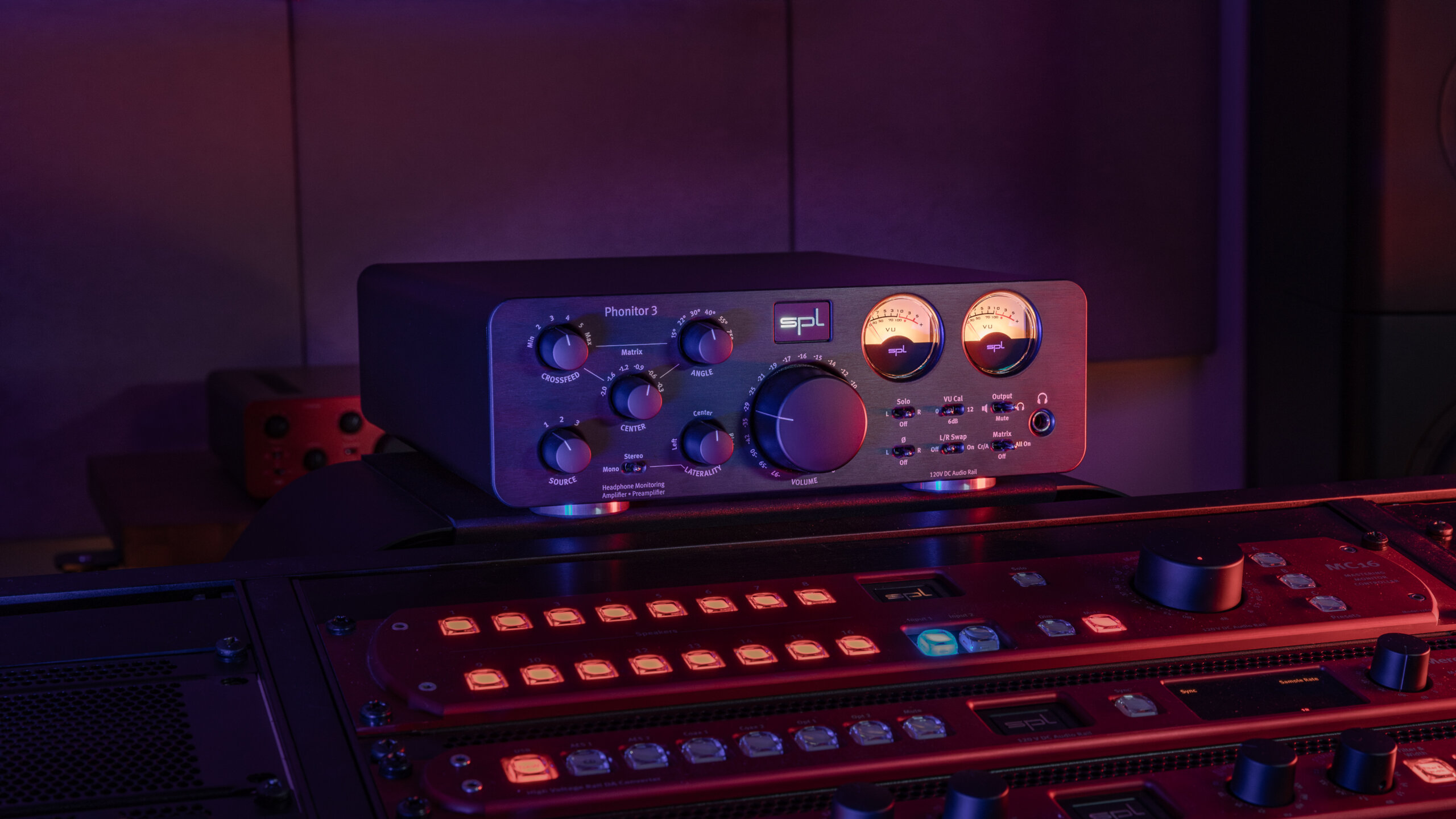
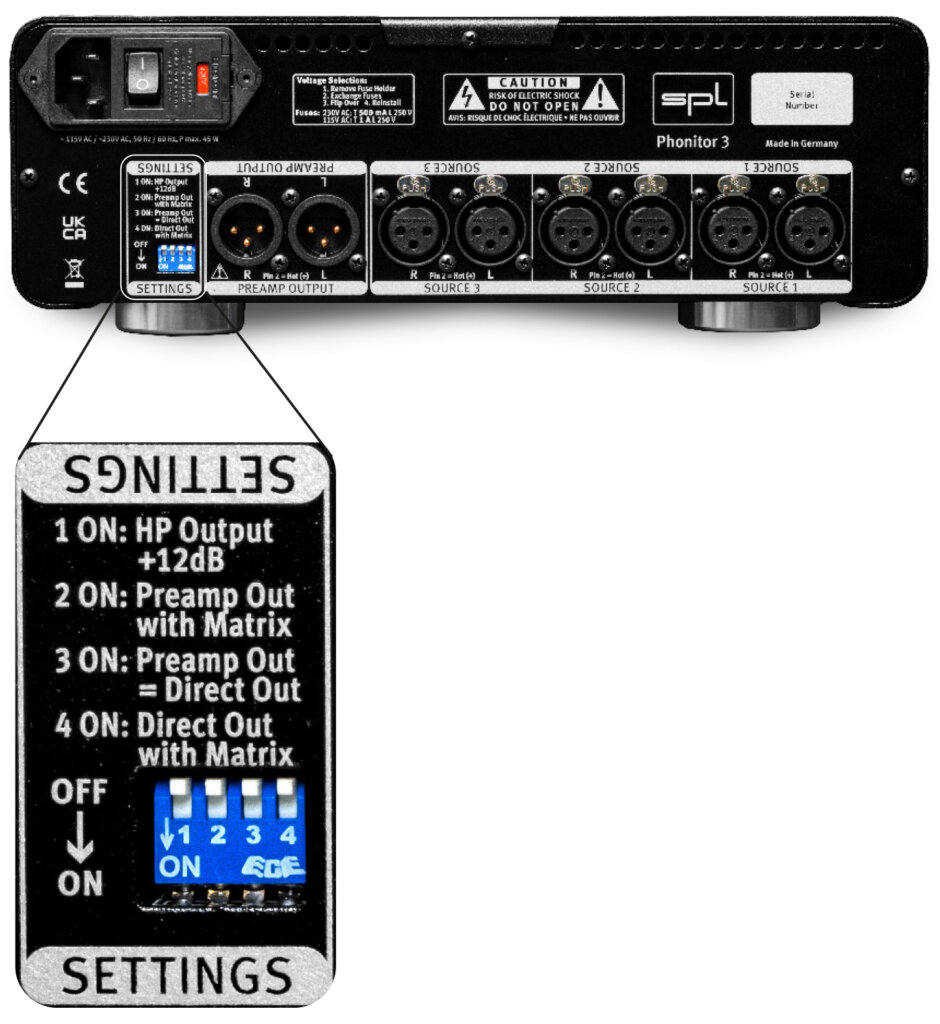
With a DIP switch on the rear of the device, the volume control for the rear stereo output can be switched out of the signal path.
But that’s not all. It is also possible to output the Phonitor Matrix to the stereo output on the rear panel of the device – regardless of whether this is configured as Preamp Out (with volume control) or Direct Out (without volume control).
If headphones have a rather low sensivity – no problem. With DIP switch 1 on the rear of the device, the level at the headphone output can be increased by 12 dB.
With all SPL devices we develop not only according to plan, but also by ear. All important components are installed on the circuit boards using Through-hole technology. This way we can ensure that we can use the best sounding components.
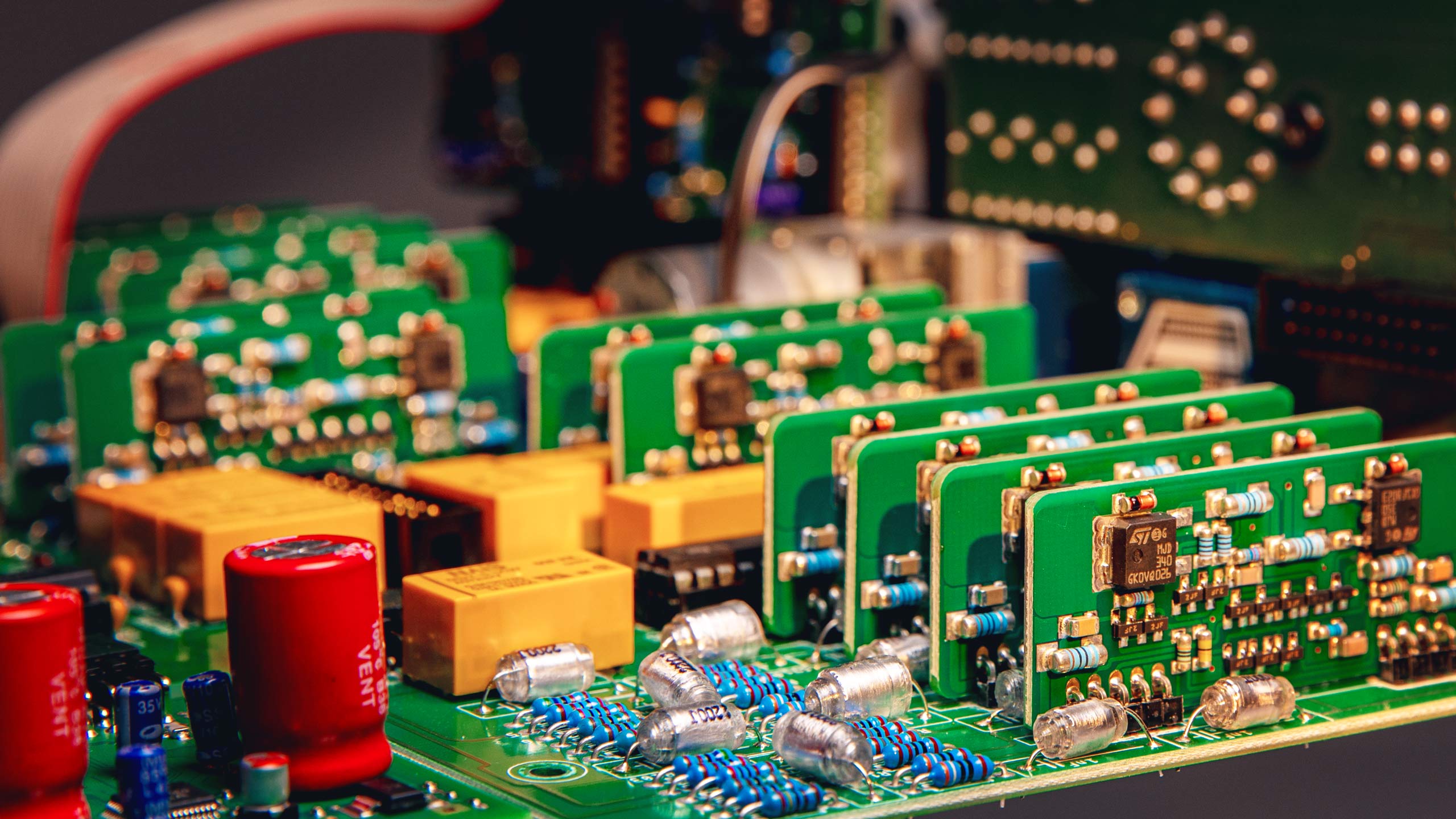
The 120V technology is our reference technology. The 120V technology is unique in the world. It operates at a DC voltage of 120 volts. This is four times that of IC-based semiconductor op-amps.
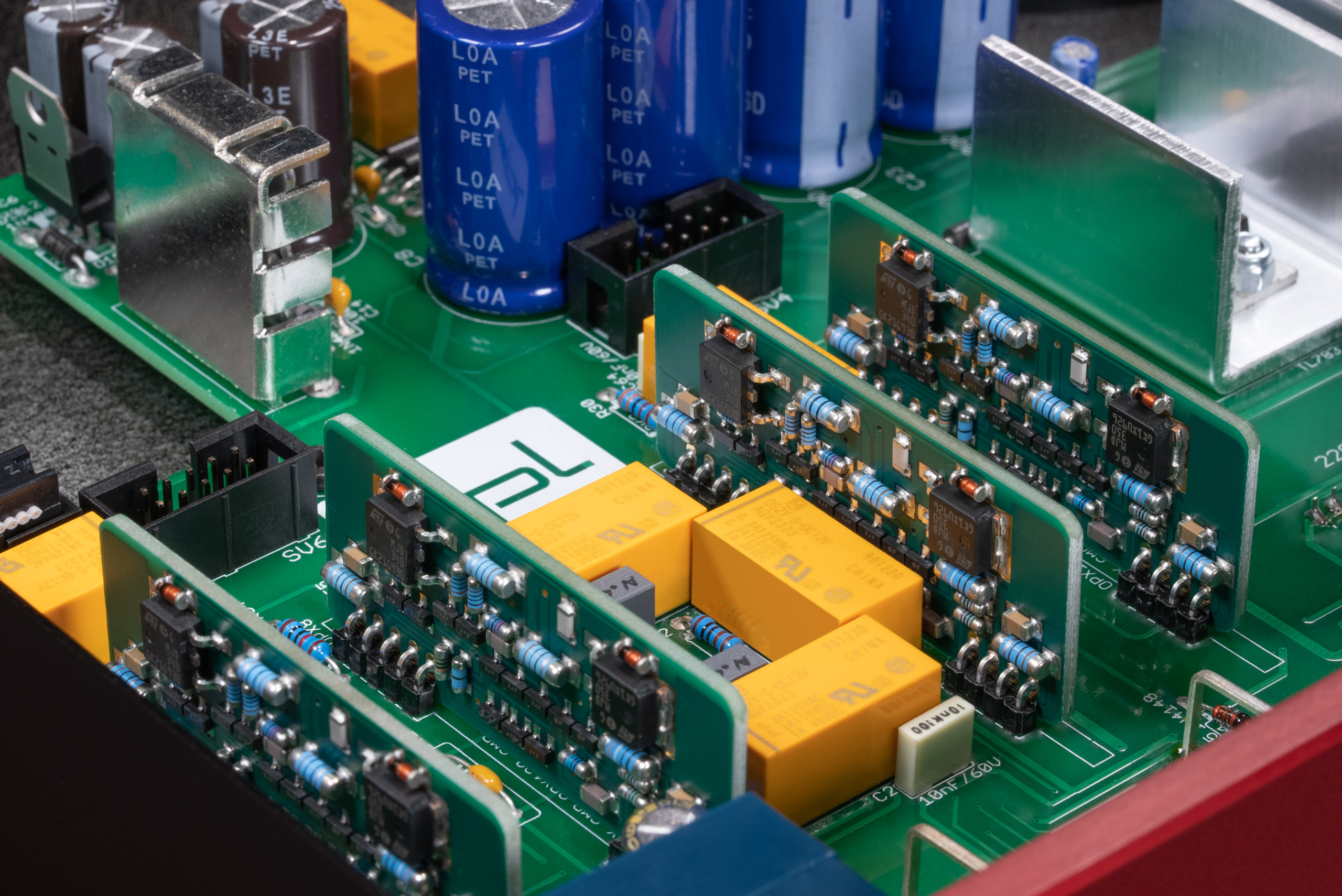
The highest possible audio quality requires the highest possible audio operating voltage.
The 120V technology works with +/-60 V. To be able to handle such a high voltage, we have developed special proprietary operational amplifiers that can operate with a DC voltage of +/-60 V: the SPL 120V SUPRA operational amplifiers.
This high voltage would destroy conventional components and operational amplifiers.
The 120V technology achieves exceptional technical specifications and sonic benefits. Technically, in terms of dynamic range, signal-to-noise ratio and headroom. Sonically, in terms of richness of detail and an absolutely relaxed listening experience.
By the way, the “120V” in the name of the technology has nothing to do with the local mains voltage from the mains power socket. This is about the operating voltage inside the device with which the audio signals are processed.
The mains voltage from the mains power socket is transformed to the required secondary voltage in the device’s internal linear power supply with toroidal transformer. Rectifiers convert this AC voltage into DC voltage required in the audio device.
The idea for SPL 120V technology and the SUPRA operational amplifier based on this technology were developed in the 1990s by SPL founder and chief developer Wolfgang Neumann.
With the goal of building the best mastering console ever, this basic technological philosophy then took shape for the first time – thus the SPL MMC1 Mastering Console for Galaxy Studios saw the light of day in 2000.
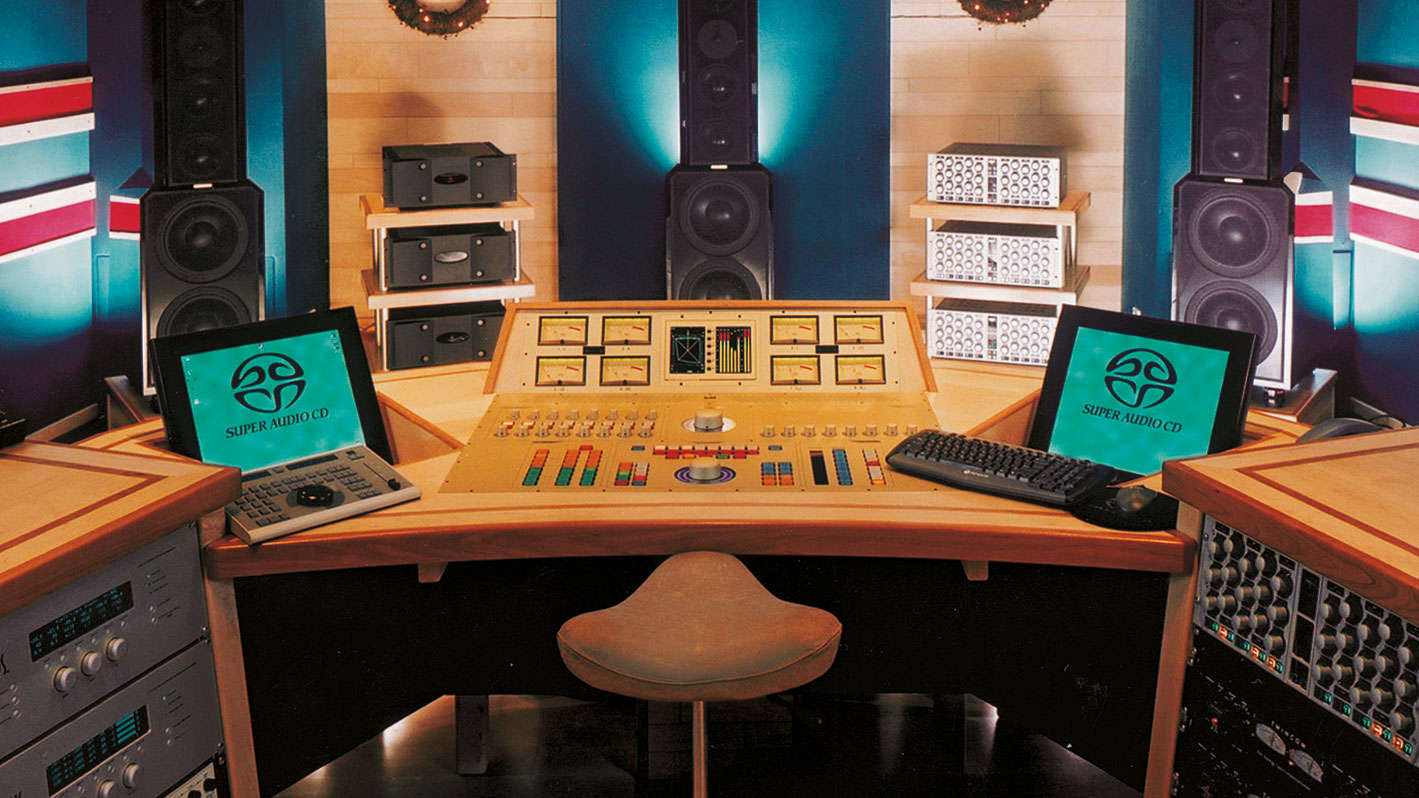

The outstanding sonic and technical features quickly got around in the scene – so further orders were not long in coming.
Besides the MMC 1, another legendary product with 120V technology was created with the PQ, the “King of Parametric Equalizers”.
Since that time, 120V technology has been the foundation for all SPL premium products. Meanwhile, not only for mastering applications, but also for the, studio or hifi use.
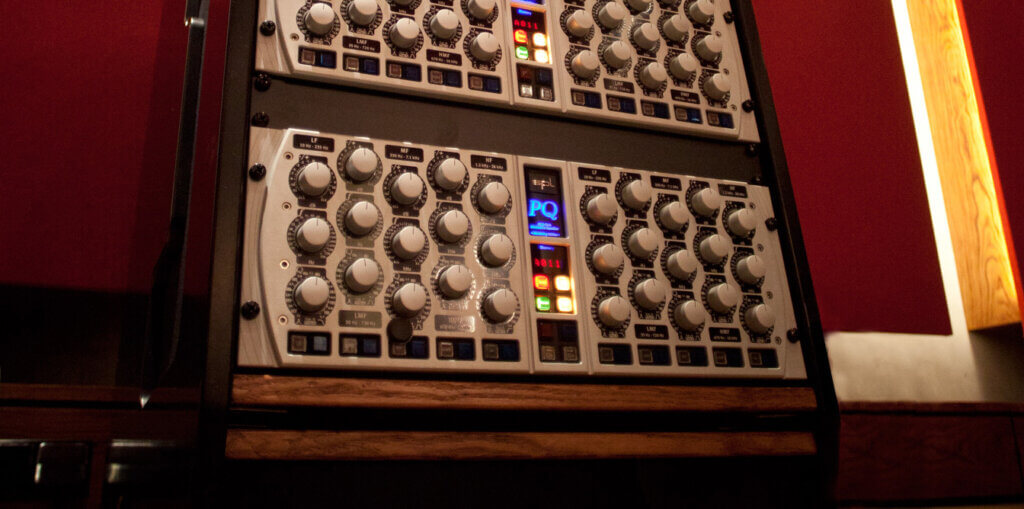

What exactly is that?
And what does it do?
Good questions need good answers.
And that’s what the 120V technology video gives you.
Most audio devices work with an internal operating voltage of +/-15 volts and can thus process a maximum input level of +21.5 dBu. If a DAC, for example, has an output level of +22 dBu at 0 dBFS, level peaks of the music material would already cause overloads in the input stage of the device.
All components in the audio device often operate at their limits. The result is an unsteady sound that causes stress and faster ear fatigue.
SPL devices with 120V technology can handle input levels of +32.5 dBu thanks to the higher internal operating voltage of +/- 60 volts – thus offering 12 dB more headroom. All components consequently operate continuously in the optimum operating range. The result is a very pleasant, natural and relaxed sound experience. So you can enjoy your music in every detail.
These diagrams clearly show the superiority of the 120V technology in comparison to other circuits with lower, common operating voltages.
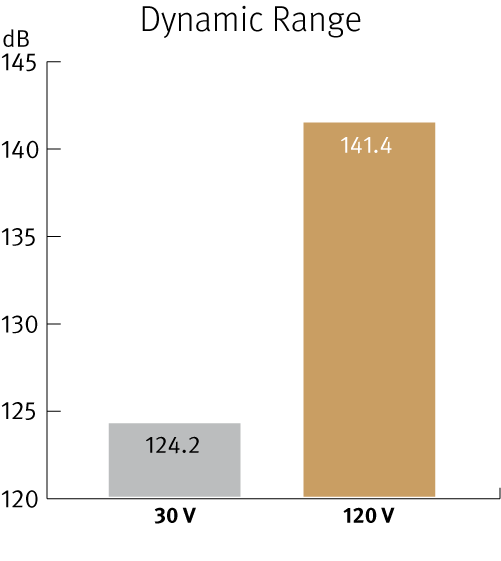
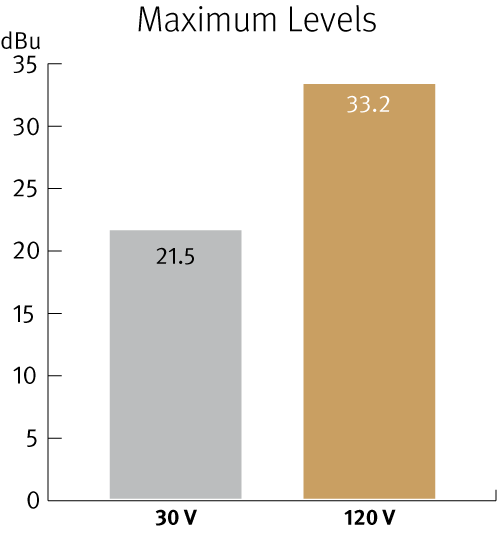
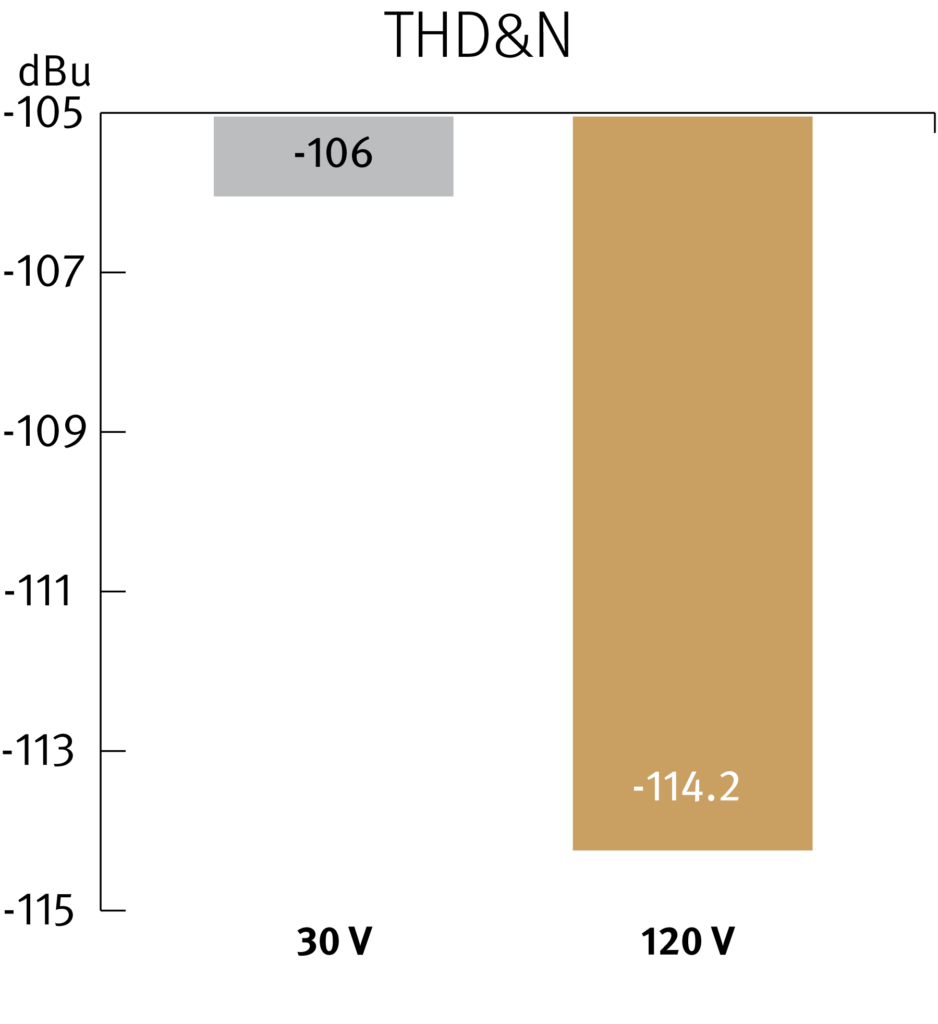
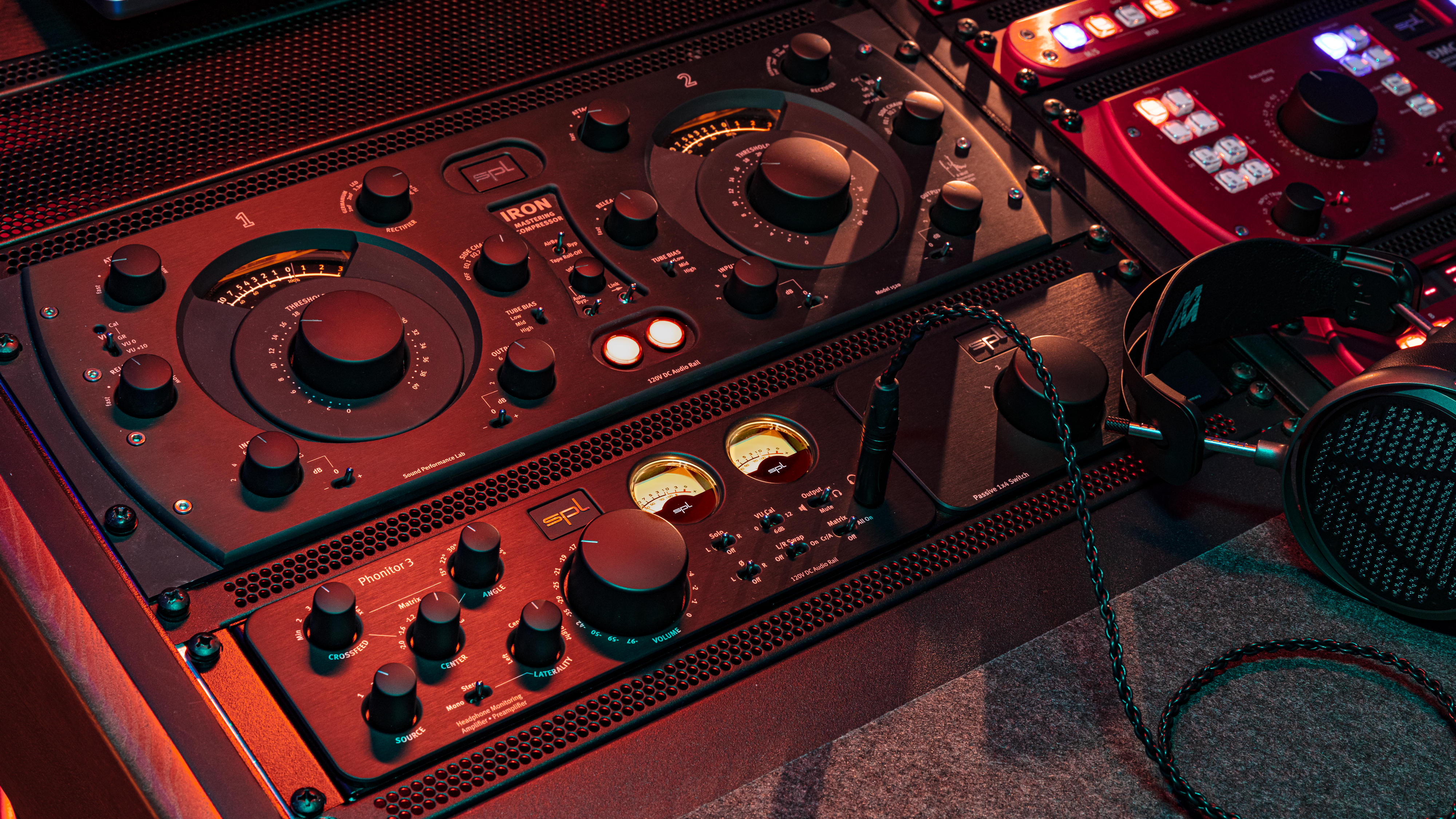

The SPL Expansion Rack is not only a 19” rack housing for the Phonitor 3 it also expands the connection possibilities.
A passive four-way switch integrated into the Expansion Rack allows the Phonitor 3 speaker output signal to be switched between up to four stereo speaker pairs.

That’s why we manufacture all devices in our own production facility in Niederkrüchten on the Lower Rhine, Germany.

The replacement of fuses and the switching of mains voltages must only be performed by qualified technicians. Fuses must only be replaced with fuses of the same type and specifications.
Reference: 0 dBu = 0.775V. All specifications are subject to change without notice.
Comparison Chart [click chart to open in a new tab]
In Stock!
The product is in stock in our warehouse in Niederkrüchten, Germany, and will be shipped the same or next working day.
We process the orders after receipt of the order and update the stock in the online shop regularly. If the product is no longer available at short notice due to high order volume, you naturally have the right to withdraw from the purchase (see Right of Withdrawal).
In any case, you will receive an e-mail with details of the delivery and the estimated delivery time.
Available soon!
The product is not in stock in our warehouse in Niederkrüchten, Germany. Usually it will be available again within 5 working days.
In any case, you will receive an e-mail with the details of the delivery and the estimated delivery time.
Of course you have the right to withdraw from your purchase (see Right of Withdrawal).
Currently unavailable.
This product is currently sold out and unavailable.
Auf Lager!
Das Produkt ist in unserem Lager Niederkrüchten vorrätig und wird noch am selben oder nächsten Werktag versendet.
Wir arbeiten die Bestellungen nach Bestelleingang ab und aktualisieren den Bestand im Online-Shop regelmäßig. Falls das Produkt wegen hohem Bestellaufkommens kurzfristig nicht mehr verfügbar ist, hast du selbstverständlich das Recht, vom Kauf zurückzutreten (siehe Widerrufbelehrung).
In jeden Fall erhältst du eine E-Mail mit den Einzelheiten der Lieferung und der voraussichtlichen Lieferzeit.
Bald verfügbar!
Das Produkt ist in unserem Lager Niederkrüchten nicht vorrätig. Gewöhnlich ist es innerhalb von 5 Werktagen wieder verfügbar.
Auf jeden Fall erhältst du eine E-Mail mit den Einzelheiten der Lieferung und der voraussichtlichen Lieferzeit.
Selbstverständlich hast du das Recht, vom Kauf zurückzutreten (siehe Widerrufbelehrung).
Zur Zeit nicht verfügbar.
Dieses Produkt ist derzeit ausverkauft und nicht verfügbar.

Due to Covid19 there are no events scheduled at this time.

Aufgrund von Covid19 sind derzeit keine Events geplant.
Notwendige Cookies sind für das ordnungsgemäße Funktionieren der Website unbedingt erforderlich. Diese Cookies stellen grundlegende Funktionalitäten und Sicherheitsmerkmale der Website sicher, anonymisiert.
| Cookie | Duration | Description |
|---|---|---|
| cookielawinfo-checbox-analytics | 11 months | This cookie is set by GDPR Cookie Consent plugin. The cookie is used to store the user consent for the cookies in the category "Analytics". |
| cookielawinfo-checbox-functional | 11 months | The cookie is set by GDPR cookie consent to record the user consent for the cookies in the category "Functional". |
| cookielawinfo-checbox-others | 11 months | This cookie is set by GDPR Cookie Consent plugin. The cookie is used to store the user consent for the cookies in the category "Other. |
| cookielawinfo-checkbox-advertisement | 1 year | The cookie is set by GDPR cookie consent to record the user consent for the cookies in the category "Advertisement". |
| cookielawinfo-checkbox-necessary | 11 months | This cookie is set by GDPR Cookie Consent plugin. The cookies is used to store the user consent for the cookies in the category "Necessary". |
| cookielawinfo-checkbox-performance | 11 months | This cookie is set by GDPR Cookie Consent plugin. The cookie is used to store the user consent for the cookies in the category "Performance". |
| gpnf_form_session_2 | 7 days | Saves entries of the spare parts request form |
| gpnf_form_session_4 | 7 days | Saves entries of the spare parts request form |
| viewed_cookie_policy | 11 months | The cookie is set by the GDPR Cookie Consent plugin and is used to store whether or not user has consented to the use of cookies. It does not store any personal data. |
Performance-Cookies werden verwendet, um die wichtigsten Leistungsindizes der Website zu verstehen und zu analysieren, was dazu beiträgt, den Besuchern ein besseres Benutzererlebnis zu bieten.
Andere nicht kategorisierte Cookies sind solche, die analysiert werden und noch nicht in eine Kategorie eingeordnet worden sind.
| Cookie | Duration | Description |
|---|---|---|
| complianz_policy_id | 1 year | No description |
Werbe-Cookies werden verwendet, um Besuchern relevante Werbung und Marketing-Kampagnen anzubieten. Diese Cookies verfolgen Besucher über Websites hinweg und sammeln Informationen, um maßgeschneiderte Werbung bereitzustellen.
Analytische Cookies werden verwendet, um zu verstehen, wie Besucher mit der Website interagieren. Diese Cookies helfen dabei, Informationen über Metriken wie die Anzahl der Besucher, Absprungrate, Verkehrsquelle usw. zu liefern.
Funktionale Cookies helfen dabei, bestimmte Funktionen auszuführen, wie z. B. das Teilen des Inhalts der Website auf Social-Media-Plattformen, das Sammeln von Feedbacks und andere Funktionen von Drittanbietern.